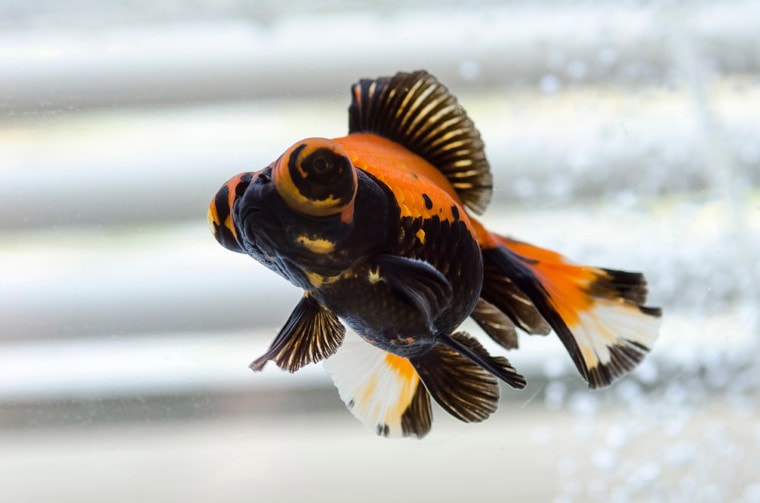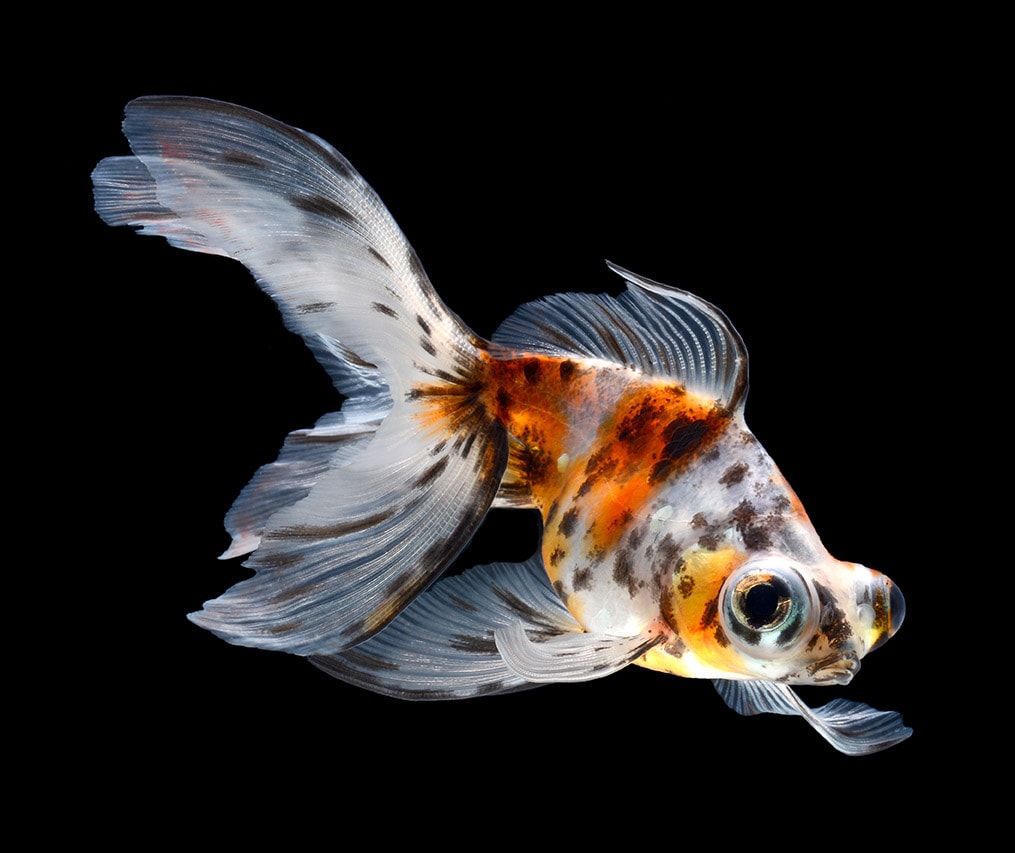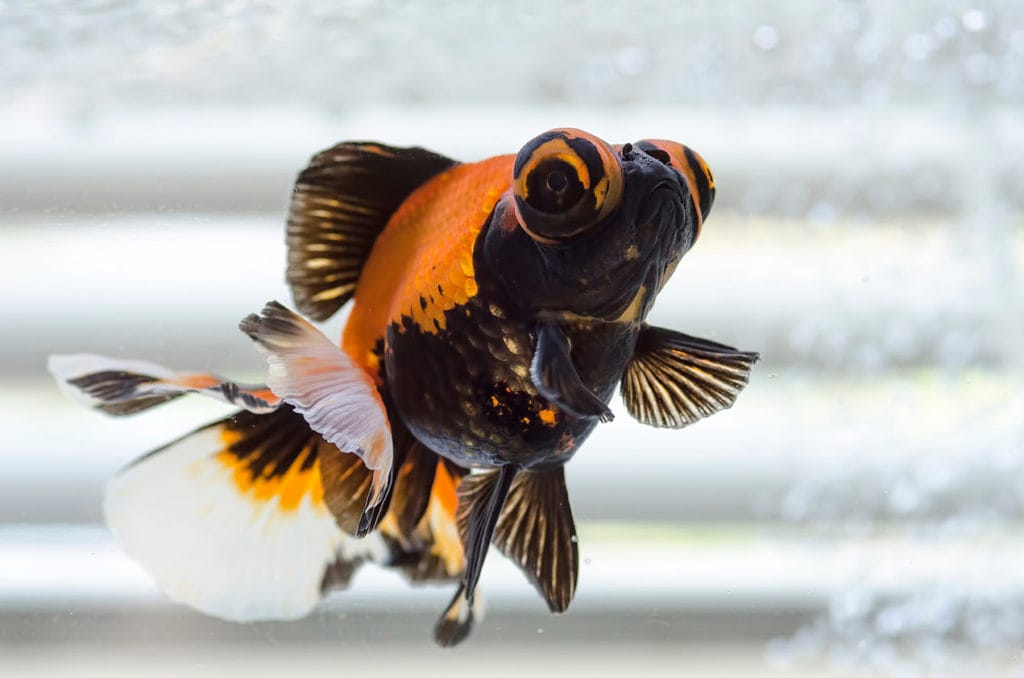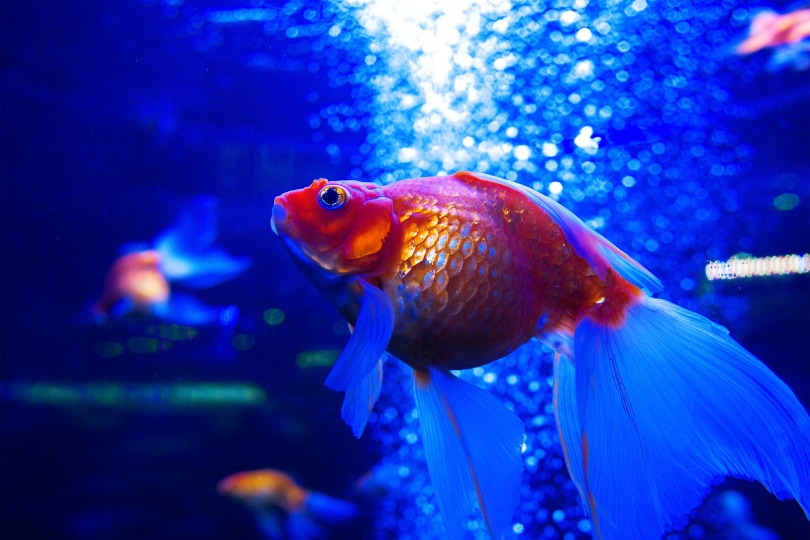
The butterfly telescope goldfish is one of the most beautiful and unique species of fancy goldfish. This is a high-quality bred goldfish that has fascinating features and colors. They come in a variety of colors and patterns that appeals to many goldfish enthusiasts. Butterfly goldfish are commonly referred to as exotic goldfish and are typically only purchasable from goldfish breeders. A show-quality butterfly goldfish will have proportionate features and a reputable coloration.
Butterfly goldfish are great for goldfish owners who have some experience in owning and caring for fancy goldfish. This article will inform you of everything you need to know about the astonishing butterfly goldfish.
Quick Facts about Butterfly Goldfish
| Species Name: | Carassius auratus |
| Family: | Minnows and Carp |
| Care Level: | Intermediate |
| Temperature: | 62°F to 77°F |
| Temperament: | Peaceful |
| Color Form: | Black, red, white, orange, bronze, yellow |
| Lifespan: | 8 to 10 years |
| Size: | 6 to 8 inches |
| Diet: | Omnivore |
| Minimum Tank Size: | 20 gallons |
| Tank Set-Up: | Freshwater: filtered, decorated, substrate |
| Compatibility: | Species-only tank |
Butterfly Goldfish Overview
The butterfly goldfish originates from China and was bought to Japan in the early 1980s where the species was then further developed to create more pronounced patterns and colors. This species of goldfish is a variation of the popular telescope goldfish that has bulging round eyes. Butterfly goldfish have the main feature that makes them stand out from other types of fancy goldfish, and this is their butterfly-shaped tail that fans out to form a butterfly when viewed from above.
Many of the expensive varieties are imported from Asia and then bred by US breeders and sold to the public. They have a mesmerizing body that easily impresses many goldfish judges, and many varieties have one various award from goldfish shows.
They are slightly more difficult to keep than other fancy varieties and are susceptible to swim bladder issues. Although they make great pets for anyone who can house and feed them appropriately.

How Much Do Butterfly Goldfish Cost?
Many butterfly goldfish specimens can be quite pricey. This is because they are not readily bred for pet stores, and you may need to contact a goldfish breeder to get your hands on a quality butterfly goldfish. Normal patterns and colorations on the butterfly goldfish can range between $20 to $80. Shipping usually costs between $25 to $60 and when paired with the price of the goldfish, it can add up to a higher price than other goldfish are sold for.
Typical Behavior & Temperament
Butterfly goldfish are peaceful fish that have minimal aggression issues. They enjoy being kept in groups of other fancy goldfish and can easily bond with their owner. Butterfly goldfish are slow-moving and enjoy being in a large environment. They are easily stressed if they are kept in a small tank and can even be housed in indoor or patio ponds. They will not pay much attention to other fish and rarely fin nip. Butterfly goldfish with heavy fins and bodies are more likely to swim a few inches above the bottom of the aquarium and may take frequent rests.

Appearance & Varieties
The butterfly goldfish is egg-shaped and has a short stubby body. The head spans wider than the body and they are paired with a set of telescope eyes. They typically grow between 6 to 8 inches when cared for properly and when housed in large bodies of water.
They live between 8 to 10 years on average, but it is not uncommon for well-cared-for butterfly goldfish to live up to 12 years. The butterfly trail is the stand-out feature of this species. The tail is what gives the goldfish their status and a good butterfly tail does not look too small or large in proportion to the rest of their body.
The body is relatively deep, and the tail is set horizontally. The lobes of the tail are shaped like outspread butterfly wings which is a beautiful attribute to the rest of their features. The dorsal fins are tall and have a hump like that on the Ryukin goldfish. The body also resembles the shape of a Ryukin, and the telescope goldfish was most likely paired with a telescope goldfish to create the butterfly goldfish.
They come in various patterns and colors such as reds, whites, pandas, orange or black.
How to Take Care of Butterfly Goldfish
Habitat, Tank Conditions & Setup
Tank/aquarium size
Butterfly goldfish require a standard rectangular tank of at least 20 gallons. They do poorly when kept in bowls, vases, or bio-orbs. Tall tanks are undesirable for these goldfish and can cause the butterfly goldfish to suffocate. These goldfish do not swim well and prefer to hang out near the bottom of the tank. If the tank has more height than length, they are unable to get oxygen from the surface. Adult butterfly goldfish do well in kiddie pools turned into a goldfish home, ponds, or large basins. Fully grown adult butterfly goldfish should be housed in at least a 40 gallon.
Water temperature & pH
These goldfish can withstand a variety of temperatures, but they do better when the water is on the warmer side. The main temperature of the tank should be between 62°F to 77°F (17°C to 25°C). The pH should be between 6.0 to 8.0 for them to be healthy.
If you are looking for help to get the water quality just right for your goldfish family in their aquarium, or just want to learn more about goldfish water quality (and more!), we recommend you check out the best-selling book, The Truth About Goldfish, on Amazon today. It covers everything from water conditioners to tank maintenance, and it also gives you full, hard copy access to their essential fishkeeping medicine cabinet!
Substrate
All species of goldfish enjoy foraging on a substrate, and this is a great way to enrich their lives and promote activity. Fine gravel or aquarium sand is an ideal substrate for butterfly goldfish. The gravel should be able to fit in their mouths and be easily spat out to prevent choking.

Plants
Butterfly goldfish should have a few live plants in their aquarium. This provides them with a fibrous snack that will help aid in digestion. Live plants also provide them with a hiding place and make them feel more comfortable in their environment.
Lighting
Butterfly goldfish prefer warm-toned lights and not bright white LED lights. A light with a warm orange glow, blue, or green color is preferred. You can also use lights that have a timer with dusk and dawn mode.
Filtration
These fish require a heavily filtered tank as butterfly goldfish are notorious for being messy. They produce a high amount of waste that increases the bioload of their tank. Alongside a filter, they should also have an aeration system and frequent water changes should be conducted.

Are Butterfly Goldfish Good Tank Mates?
Butterfly goldfish should be housed in a species-specific tank. They do not get along with other types of fish and shrimp. Butterfly goldfish are best housed with other fancy varieties like Orandas, Ranchu, Ryukin, Fantails, or telescope goldfish.
They should never be housed with tropical fish or crustaceans. The temperatures are vastly different, and the goldfish will usually eat smaller tank mates when they grow large enough. A good tank mate for butterfly goldfish is large apple snails. Smaller snails will be eaten by the goldfish, and this puts them at risk of choking.
What to Feed Your Butterfly Goldfish
Butterfly goldfish are natural omnivores and require a diet both rich in plant and protein-based matter. A portion of high-quality food is recommended as a staple diet and live foods and supplements should be fed as snacks.
High protein levels in a butterfly goldfish’s diet can contribute to digestion problems like constipation. They require a high number of plant and algae materials to aid in digestion and minimize their chances of developing bloat. Excess bloat can cause them to have problems with their swim bladder organs and they will become unstable in the water.
Deshelled peas, blanched romaine lettuce, spinach, zucchini, and cucumber are healthy snack alternatives. You can also feed your butterfly goldfish live or freeze-dried foods such as bloodworms, insect larvae, tubifex worms, or brine shrimp. Protein should be higher in young goldfish who will use the nutrients to grow. The protein level should be lowered as they reach over two years old.
Keeping Your Butterfly Goldfish Healthy
Step 1: House your butterfly goldfish in a large tank. Follow a simply stocking rule of 20 gallons per one juvenile butterfly goldfish and 10 gallons for each additional goldfish. You should house your butterfly goldfish in a pond you must ensure that it is a round shape to prevent them from getting trapped in tight corners.
Step 2: Provide your butterfly goldfish with a strong filter to house beneficial bacteria that will convert ammonia into nitrates. The tank should be cycled for several weeks before adding in your new butterfly goldfish.
Step 3: Keep an air stone inside of the tank to promote oxygenation. The surface should constantly be moving to provide aeration for your butterfly telescopes.
Step 4: Test the water using a liquid testing kit. The reading should say 0ppm Ammonia and Nitrite, and 5 to 25ppm nitrate. Water changes should be done weekly to dilute the build-up of toxins in the water.
Step 5: Feed butterfly goldfish a healthy and complete diet to fulfill their nutritional needs. All foods should be fresh and commercial foods should be well before their expiry date. Do not soak foods before feeding as it will leach out the nutrients your goldfish needs.
Breeding
To successfully breed butterfly goldfish, you want to keep them in mixed groups of males and females. A ratio of 3 females and one male will work. You should prepare a breeding tank or spawning mop so that their eggs and fry have somewhere to hide. Butterfly goldfish have no parental care for their young and will eat them. A heater, filter, and aeration system should be placed in the breeding tank.
To encourage butterfly goldfish to breed, you should feed them live foods every second day and gradually increase the temperature over a week. As soon as the temperature drops again, they will be encouraged to spawn, and the female will deposit her eggs across plants in the tank. The male butterfly goldfish will then fertilize the eggs. Fertilization takes place externally and both genders are required in the breeding process.
Are Butterfly Goldfish Suitable for Your Aquarium?
If you are prepared to keep a large tank with a filter and aeration system, butterfly goldfish are a good stocking option. They will add character and color to many household tanks or ponds while providing a mesmerizing view from above and on the side.
Butterfly goldfish can also be placed in established tanks that already have fancy goldfish inside. They will get along with many species of goldfish and enjoy the company.
We hope this article has helped you to understand the care requirements of the butterfly goldfish!
Featured Image Credit: stuphipps, Shutterstock











